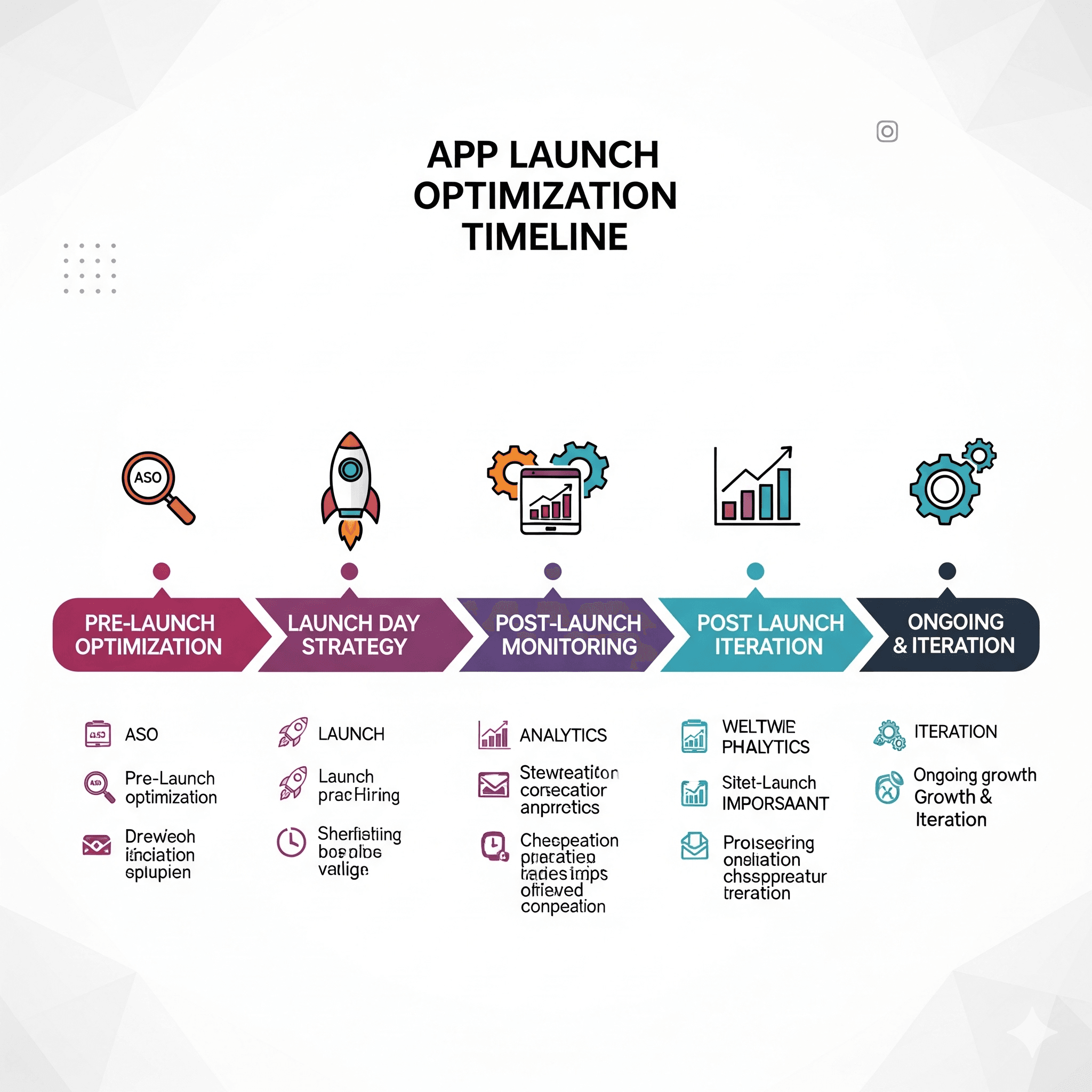Mobile App Performance Optimization
Learn techniques to improve your mobile app's performance, loading times, and user experience.

Introduction
Understanding Mobile Performance Metrics
Effective performance optimization starts with understanding key metrics that impact user experience, from app launch time to memory consumption and battery usage.
| Metric | Target | Impact | Measurement Tool |
|---|---|---|---|
| App Launch Time | < 2 seconds | First impression | Instruments, Systrace |
| Frame Rate | 60 FPS | Smooth animations | GPU Profiler |
| Memory Usage | < 100MB | App stability | Memory Profiler |
| Battery Drain | Minimal | User satisfaction | Battery Historian |
| Network Latency | < 200ms | Data loading | Network Monitor |
| App Size | < 50MB | Download conversion | Bundle Analyzer |
Performance Impact
A 1-second delay in mobile app response time can result in a 7% reduction in conversions and a 16% decrease in user satisfaction.
App Launch Optimization
App launch time is the first performance indicator users experience. Optimizing cold, warm, and hot start times requires strategic initialization and lazy loading techniques.
import React, { useState, useEffect } from 'react';
import { AppState } from 'react-native';
import AsyncStorage from '@react-native-async-storage/async-storage';
// Lazy load heavy components
const HeavyComponent = React.lazy(() => import('./HeavyComponent'));
class AppLaunchOptimizer {
static preloadCriticalData = async () => {
// Load only essential data during app initialization
try {
const criticalData = await Promise.allSettled([
AsyncStorage.getItem('user_token'),
AsyncStorage.getItem('user_preferences'),
// Avoid loading large datasets here
]);
return criticalData;
} catch (error) {
console.error('Failed to preload critical data:', error);
}
};
static deferNonCriticalTasks = () => {
// Defer analytics, crash reporting, etc.
setTimeout(() => {
// Initialize analytics
// Setup crash reporting
// Load non-critical preferences
}, 2000); // Defer by 2 seconds
};
static optimizeImageLoading = () => {
// Preload critical images only
const criticalImages = [
require('./assets/splash-logo.png'),
require('./assets/main-bg.png'),
];
return criticalImages;
};
}
const App = () => {
const [isReady, setIsReady] = useState(false);
const [appState, setAppState] = useState(AppState.currentState);
useEffect(() => {
const initializeApp = async () => {
// Start critical tasks
await AppLaunchOptimizer.preloadCriticalData();
// Set app as ready
setIsReady(true);
// Defer non-critical tasks
AppLaunchOptimizer.deferNonCriticalTasks();
};
initializeApp();
// Handle app state changes for performance
const handleAppStateChange = (nextAppState) => {
if (appState.match(/inactive|background/) && nextAppState === 'active') {
// App has come to foreground - optimize warm start
console.log('App warm start optimization');
}
setAppState(nextAppState);
};
const subscription = AppState.addEventListener('change', handleAppStateChange);
return () => subscription?.remove();
}, [appState]);
if (!isReady) {
return <SplashScreen />; // Lightweight splash screen
}
return (
<React.Suspense fallback={<LoadingScreen />}>
<MainApp />
</React.Suspense>
);
};
export default App;
Memory Management and Optimization
Effective memory management prevents crashes, reduces battery drain, and ensures smooth app performance across devices with varying memory capabilities.
- Image Optimization: Compress images and use appropriate formats
- Memory Leaks Prevention: Properly cleanup listeners and subscriptions
- Lazy Loading: Load components and data only when needed
- Caching Strategy: Implement intelligent caching with size limits
- Background Tasks: Minimize background processing
import { Image, Dimensions } from 'react-native';
import FastImage from 'react-native-fast-image';
class ImageOptimizer {
static getOptimizedImageSize = (originalWidth, originalHeight, maxWidth = 300) => {
const screenWidth = Dimensions.get('window').width;
const targetWidth = Math.min(maxWidth, screenWidth * 0.8);
if (originalWidth <= targetWidth) {
return { width: originalWidth, height: originalHeight };
}
const ratio = targetWidth / originalWidth;
return {
width: targetWidth,
height: originalHeight * ratio,
};
};
static preloadCriticalImages = (imageUris) => {
// Preload only critical images
const criticalImages = imageUris.slice(0, 5); // Limit to first 5
FastImage.preload(criticalImages.map(uri => ({
uri,
priority: FastImage.priority.high,
})));
};
static createImageCache = () => {
const cache = new Map();
const maxSize = 50; // Limit cache size
return {
get: (key) => cache.get(key),
set: (key, value) => {
if (cache.size >= maxSize) {
const firstKey = cache.keys().next().value;
cache.delete(firstKey);
}
cache.set(key, value);
},
clear: () => cache.clear(),
size: () => cache.size,
};
};
}
// Memory-efficient image component
const OptimizedImage = ({ uri, style, ...props }) => {
const [dimensions, setDimensions] = useState(null);
useEffect(() => {
if (uri) {
Image.getSize(uri, (width, height) => {
const optimizedSize = ImageOptimizer.getOptimizedImageSize(width, height);
setDimensions(optimizedSize);
});
}
}, [uri]);
if (!dimensions) {
return <PlaceholderImage style={style} />;
}
return (
<FastImage
source={{ uri, priority: FastImage.priority.normal }}
style={[style, dimensions]}
resizeMode={FastImage.resizeMode.contain}
onError={(error) => console.warn('Image loading error:', error)}
{...props}
/>
);
};
export default OptimizedImage;Network Performance Optimization
Network operations significantly impact app performance. Implementing efficient data fetching, caching, and offline capabilities improves user experience across varying network conditions.
import NetInfo from '@react-native-netinfo/netinfo';
import AsyncStorage from '@react-native-async-storage/async-storage';
class NetworkOptimizer {
constructor() {
this.requestQueue = [];
this.isOnline = true;
this.cache = new Map();
this.initNetworkListener();
}
initNetworkListener = () => {
NetInfo.addEventListener(state => {
this.isOnline = state.isConnected;
if (this.isOnline) {
this.processQueuedRequests();
}
});
};
// Intelligent request batching
batchRequests = (requests, batchSize = 3) => {
const batches = [];
for (let i = 0; i < requests.length; i += batchSize) {
batches.push(requests.slice(i, i + batchSize));
}
return batches;
};
// Smart caching with TTL
getCachedData = async (key, ttl = 300000) => { // 5 minutes default TTL
try {
const cached = await AsyncStorage.getItem(`cache_${key}`);
if (cached) {
const { data, timestamp } = JSON.parse(cached);
if (Date.now() - timestamp < ttl) {
return data;
}
await AsyncStorage.removeItem(`cache_${key}`);
}
} catch (error) {
console.warn('Cache retrieval error:', error);
}
return null;
};
setCachedData = async (key, data) => {
try {
const cacheEntry = {
data,
timestamp: Date.now(),
};
await AsyncStorage.setItem(`cache_${key}`, JSON.stringify(cacheEntry));
} catch (error) {
console.warn('Cache storage error:', error);
}
};
// Optimized fetch with retry logic
optimizedFetch = async (url, options = {}, retries = 2) => {
const cacheKey = `${url}_${JSON.stringify(options)}`;
// Check cache first
const cachedData = await this.getCachedData(cacheKey);
if (cachedData) {
return cachedData;
}
// If offline, queue request
if (!this.isOnline) {
return new Promise((resolve, reject) => {
this.requestQueue.push({ url, options, resolve, reject });
});
}
// Enhanced fetch with timeout and retry
const controller = new AbortController();
const timeoutId = setTimeout(() => controller.abort(), 10000); // 10s timeout
try {
const response = await fetch(url, {
...options,
signal: controller.signal,
});
clearTimeout(timeoutId);
if (!response.ok) {
throw new Error(`HTTP ${response.status}`);
}
const data = await response.json();
// Cache successful responses
await this.setCachedData(cacheKey, data);
return data;
} catch (error) {
clearTimeout(timeoutId);
if (retries > 0 && error.name !== 'AbortError') {
await new Promise(resolve => setTimeout(resolve, 1000)); // 1s delay
return this.optimizedFetch(url, options, retries - 1);
}
throw error;
}
};
processQueuedRequests = () => {
const requests = [...this.requestQueue];
this.requestQueue = [];
requests.forEach(async ({ url, options, resolve, reject }) => {
try {
const result = await this.optimizedFetch(url, options);
resolve(result);
} catch (error) {
reject(error);
}
});
};
// Preload critical data
preloadData = async (urls) => {
if (!this.isOnline) return;
const batches = this.batchRequests(urls);
for (const batch of batches) {
await Promise.allSettled(
batch.map(url => this.optimizedFetch(url))
);
// Small delay between batches to prevent overwhelming the network
await new Promise(resolve => setTimeout(resolve, 100));
}
};
}
// Usage example
const networkOptimizer = new NetworkOptimizer();
export const useOptimizedApi = () => {
const fetchData = async (endpoint) => {
try {
return await networkOptimizer.optimizedFetch(endpoint);
} catch (error) {
console.error('API call failed:', error);
throw error;
}
};
return { fetchData };
};
export default NetworkOptimizer;Network Optimization Tip
Implement progressive loading for lists and use pagination to avoid loading large datasets at once, especially on slower networks.
UI Performance and Rendering
Smooth UI performance requires optimizing rendering cycles, minimizing layout calculations, and implementing efficient list rendering for large datasets.
- Use FlatList or VirtualizedList for large datasets
- Implement shouldComponentUpdate or React.memo for unnecessary re-renders
- Optimize animations with native drivers
- Minimize bridge communications between JS and native layers
- Use getItemLayout for known item dimensions
import React, { memo, useMemo, useCallback } from 'react';
import { FlatList, View, Text, StyleSheet } from 'react-native';
// Memoized list item to prevent unnecessary re-renders
const ListItem = memo(({ item, onPress }) => {
const handlePress = useCallback(() => {
onPress(item.id);
}, [item.id, onPress]);
return (
<TouchableOpacity style={styles.item} onPress={handlePress}>
<Text style={styles.title}>{item.title}</Text>
<Text style={styles.subtitle}>{item.subtitle}</Text>
</TouchableOpacity>
);
});
// Optimized FlatList implementation
const OptimizedList = ({ data, onItemPress }) => {
// Memoize keyExtractor to prevent recreation
const keyExtractor = useCallback((item) => item.id.toString(), []);
// Memoize renderItem to prevent recreation
const renderItem = useCallback(({ item }) => (
<ListItem item={item} onPress={onItemPress} />
), [onItemPress]);
// Pre-calculate item layout if dimensions are known
const getItemLayout = useCallback((data, index) => ({
length: 80, // Known item height
offset: 80 * index,
index,
}), []);
// Memoize list footer component
const ListFooterComponent = useMemo(() => (
<View style={styles.footer}>
<Text>End of list</Text>
</View>
), []);
return (
<FlatList
data={data}
keyExtractor={keyExtractor}
renderItem={renderItem}
getItemLayout={getItemLayout}
ListFooterComponent={ListFooterComponent}
// Performance optimizations
removeClippedSubviews={true}
maxToRenderPerBatch={10}
updateCellsBatchingPeriod={50}
initialNumToRender={10}
windowSize={10}
// Reduce memory footprint
legacyImplementation={false}
disableVirtualization={false}
/>
);
};
const styles = StyleSheet.create({
item: {
height: 80,
padding: 16,
borderBottomWidth: 1,
borderBottomColor: '#eee',
justifyContent: 'center',
},
title: {
fontSize: 16,
fontWeight: 'bold',
},
subtitle: {
fontSize: 14,
color: '#666',
marginTop: 4,
},
footer: {
padding: 20,
alignItems: 'center',
},
});
export default OptimizedList;
Animation Performance
Smooth animations significantly improve user experience. Using native drivers and optimizing animation sequences ensures 60 FPS performance across all devices.
import React, { useRef, useEffect } from 'react';
import { Animated, Easing } from 'react-native';
const OptimizedAnimations = () => {
const fadeAnim = useRef(new Animated.Value(0)).current;
const scaleAnim = useRef(new Animated.Value(0.8)).current;
const translateAnim = useRef(new Animated.Value(-100)).current;
// Optimized fade in animation with native driver
const fadeIn = useCallback(() => {
Animated.timing(fadeAnim, {
toValue: 1,
duration: 300,
useNativeDriver: true, // Essential for 60fps
easing: Easing.out(Easing.cubic),
}).start();
}, [fadeAnim]);
// Parallel animations for better performance
const animateEntry = useCallback(() => {
Animated.parallel([
Animated.timing(fadeAnim, {
toValue: 1,
duration: 300,
useNativeDriver: true,
}),
Animated.spring(scaleAnim, {
toValue: 1,
tension: 100,
friction: 8,
useNativeDriver: true,
}),
Animated.timing(translateAnim, {
toValue: 0,
duration: 400,
useNativeDriver: true,
easing: Easing.bezier(0.25, 0.46, 0.45, 0.94),
}),
]).start();
}, [fadeAnim, scaleAnim, translateAnim]);
// Sequence animations with proper cleanup
const sequentialAnimation = useCallback(() => {
Animated.sequence([
Animated.timing(scaleAnim, {
toValue: 1.1,
duration: 150,
useNativeDriver: true,
}),
Animated.timing(scaleAnim, {
toValue: 1,
duration: 150,
useNativeDriver: true,
}),
]).start();
}, [scaleAnim]);
return (
<Animated.View
style={{
opacity: fadeAnim,
transform: [
{ scale: scaleAnim },
{ translateY: translateAnim },
],
}}
>
{/* Your content here */}
</Animated.View>
);
};Bundle Size and Code Splitting
Reducing app bundle size improves download times and device storage usage. Strategic code splitting and tree shaking eliminate unused code and defer non-critical components.
| Technique | Impact | Implementation | Savings |
|---|---|---|---|
| Tree Shaking | Remove unused code | ES6 modules, Webpack | 20-30% |
| Code Splitting | Lazy load components | Dynamic imports | 40-50% |
| Image Optimization | Compress assets | WebP, AVIF formats | 60-80% |
| Font Optimization | Subset fonts | Custom font builds | 70-90% |
| Library Auditing | Remove unused deps | Bundle analyzers | 10-20% |
#!/bin/bash
# React Native bundle analysis and optimization
# Generate bundle report
npx react-native bundle \
--platform android \
--dev false \
--entry-file index.js \
--bundle-output android-release.bundle \
--sourcemap-output android-release.bundle.map
# Analyze bundle size
npx @react-native-community/cli bundle \
--platform android \
--dev false \
--minify true \
--verbose
# Check for unused dependencies
npx depcheck
# Analyze package sizes
npx bundle-phobia-cli
# Generate bundle visualization
npx react-native-bundle-visualizer
echo "Bundle analysis complete. Check the generated reports."Optimization Result
Implementing these bundle optimization techniques typically reduces app size by 40-60% and improves initial load time by 2-3 seconds.
Device-Specific Optimization
Modern mobile apps must perform well across a wide range of devices with varying capabilities. Implementing adaptive performance strategies ensures consistent user experience.
import { Dimensions, Platform } from 'react-native';
import DeviceInfo from 'react-native-device-info';
class DeviceOptimizer {
static async getDeviceCapabilities() {
const [totalMemory, usedMemory, deviceType] = await Promise.all([
DeviceInfo.getTotalMemory(),
DeviceInfo.getUsedMemory(),
DeviceInfo.getDeviceType(),
]);
const availableMemory = totalMemory - usedMemory;
const screenData = Dimensions.get('screen');
return {
memory: {
total: totalMemory,
available: availableMemory,
usage: (usedMemory / totalMemory) * 100,
},
screen: {
width: screenData.width,
height: screenData.height,
scale: screenData.scale,
},
deviceType,
platform: Platform.OS,
};
}
static getPerformanceProfile(capabilities) {
const { memory, screen } = capabilities;
// Define performance tiers
if (memory.total > 4000000000) { // > 4GB
return 'high';
} else if (memory.total > 2000000000) { // > 2GB
return 'medium';
} else {
return 'low';
}
}
static getOptimizedSettings(performanceProfile) {
const settings = {
high: {
imageQuality: 1.0,
animationDuration: 300,
listPageSize: 50,
cacheSize: 100,
enableComplexAnimations: true,
},
medium: {
imageQuality: 0.8,
animationDuration: 200,
listPageSize: 30,
cacheSize: 50,
enableComplexAnimations: true,
},
low: {
imageQuality: 0.6,
animationDuration: 150,
listPageSize: 20,
cacheSize: 25,
enableComplexAnimations: false,
},
};
return settings[performanceProfile] || settings.medium;
}
}
// Usage in app
const useDeviceOptimization = () => {
const [settings, setSettings] = useState(null);
useEffect(() => {
const initializeOptimization = async () => {
const capabilities = await DeviceOptimizer.getDeviceCapabilities();
const profile = DeviceOptimizer.getPerformanceProfile(capabilities);
const optimizedSettings = DeviceOptimizer.getOptimizedSettings(profile);
setSettings(optimizedSettings);
};
initializeOptimization();
}, []);
return settings;
};
export default useDeviceOptimization;
Performance Monitoring and Analytics
Continuous performance monitoring provides insights into real-world app performance, helping identify bottlenecks and measure optimization impact.
- Real-time Metrics: Track FPS, memory usage, and crash rates
- User Experience Analytics: Monitor app launch times and screen transitions
- Performance Alerts: Set thresholds for critical performance indicators
- A/B Testing: Compare performance impact of different optimizations
- Device Segmentation: Analyze performance across different device types
"Performance is not just about speed—it's about creating delightful user experiences that keep users engaged and coming back."
— Mobile UX Design Principle
Conclusion
Mobile app performance optimization is an ongoing process that requires systematic measurement, targeted improvements, and continuous monitoring. By implementing these techniques—from launch optimization to device-specific adaptations—you can create apps that deliver exceptional user experiences across all devices and network conditions.
Reading Progress
0% completed
Article Insights
Share Article
Quick Actions
Stay Updated
Join 12k+ readers worldwide
Get the latest insights, tutorials, and industry news delivered straight to your inbox. No spam, just quality content.
Unsubscribe at any time. No spam, ever. 🚀
